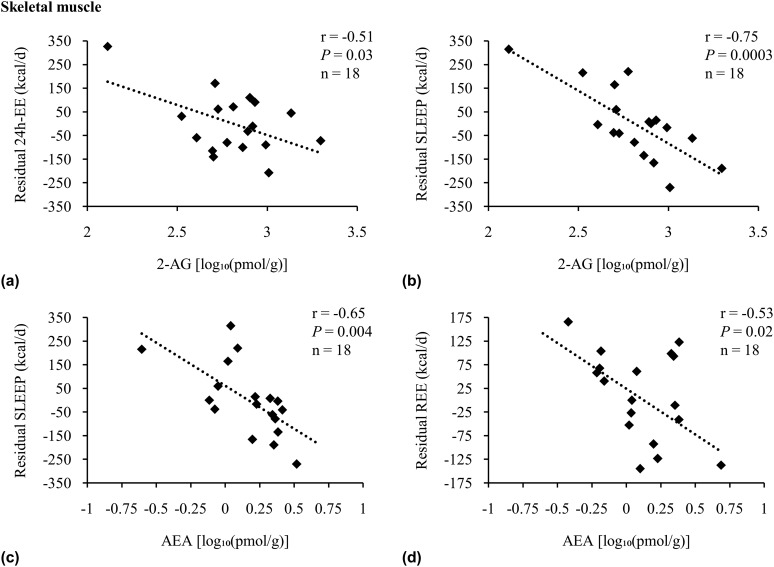Figure 1.
Adjusted correlations of residual measures of EE with skeletal muscle AEA and 2-AG. Association analysis of 2-AG with residuals of (a) 24-hour EE and (b) SLEEP, as well as AEA with residuals of (c) SLEEP and (d) REE in Native Americans of full Southwestern heritage. Twenty-four-hour EE, SLEEP, and REE were adjusted for age, sex, FM, and FFM. Twenty-four-hour EE was also adjusted for spontaneous physical activity (25). Endocannabinoids and OEA concentrations were log10-transformed to reduce the influence of extreme values on the multivariate model. Sensitivity analyses were performed for (a) dFβ = −3.69 standard deviation (SD), r = −0.13, P = 0.62; (b) dFβ = 1.96 SD, r = −0.67, P = 0.003; and (c) dFβ = 2.46 SD, r = −0.58, P = 0.01. Pearson correlation (r) reported. Due to incomplete EE and/or lipid assessment in skeletal muscle, the number of individuals included here in the presented analyses differed from the overall group of 21 Native Americans of full Southwestern heritage. Compared with the latter, these participants were not different regarding age, sex, FM, FFM, body mass index, percentage body fat, glucose regulation, and AEA, 2-AG, and OEA tissue and plasma concentrations (all P > 0.05). Individuals with EE measured using a whole-room indirect calorimeter (n = 18) and those with REE measured using the ventilated hood method (n = 18) were two different subgroups from the 21 individuals with lipid concentrations assessed in skeletal muscle. In sensitivity analyses considering age, sex, FM, FFM, body mass index, percentage body fat, glucose regulation, and AEA, 2-AG, and OEA tissue and plasma concentrations, both groups were not different from each other or the overall study population of at least half and full Native Americans of Southwestern heritage (all P > 0.05).

